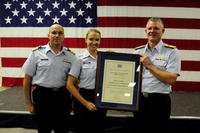News of dogs serving in a war isn’t anything new. It’s a practice that’s been done for decades; the United States began steadily using dogs for fighting and training purposes during World War II. However, as a new program, there wasn’t a force of dogs to choose from. Handlers had to train dogs, and obtaining them wasn’t exactly easy.
Prior to this effort, the only use of dogs in the military were sled dogs in certain arctic regions.

At first, any and all dogs were accepted into military ranks through a coalition known as Dogs for Defense Inc. (DFD). Any breed, so long as the owner was willing to part with them, was given a go at military operations. Donation centers opened up where anyone and everyone could donate their dog to help war efforts. The goal was for dogs to patrol borders, beaches, etc., and not only intimidate wrongdoers but note anything out of the ordinary.
In a time when patriotism was key and one of the main duties of civilians back home was to support their country, many Americans felt the need to help by donating their dog to help. Dogs were promised to be “deprogrammed” and returned once WWII was complete.
More often than not, that meant a family dog was donated to war. In total, more than 20,000 were taken in to help with WWII. Just like soldiers, dogs were evaluated medically; those that did not pass were returned home. Remaining dogs were then given a training test to ensure they could perform certain tasks.
It soon became apparent that breed mattered when it came to training and enforcing operations, with the Army only accepting a few different dog breeds for combat. (The Army was the first military branch to accept dogs into their ranks.)
Accepted breeds included:
- German Shepherd
- Doberman pinscher
- Belgian sheepdog
- Collie
- Siberian husky
- Malamute
- Eskimo dog
These dogs were chosen because of their ability to learn, eagerness to work, perform tasks assigned to them and withstand various weather conditions.
While this move created dogs who were better trained and more productive, it also made finding dogs much harder. Now there wasn’t an unlimited amount of dogs that could be donated to the cause, but a mere few types of breeds.

Another thing that became apparent is that dogs needed to trust their handler. The best way to gain that trust was to have them trained with their assigned soldier. In some cases, and for soldiers who had a specific breed of dog, that again meant bringing their family dog to basic training.
Today it’s a scenario we can hardly imagine. A mass drop-off of dogs who were supposed to learn to fight in one way or another – a far cry from a life of chewing sticks and begging at the dinner table. In addition, canine training is now a strict and effective program that dogs partake in from a young age, allowing them to be smart and effective soldiers from stages as a pup.
Like any military intelligence, it was soon learned that there were better ways to improve the program, such as narrowing breeds and training with a single soldier for each dog. These adjustments allowed for more dogs to join and find success in the military. In addition, it allowed military branches to accomplish more with the help of our canine friends.
More articles from We Are the Mighty:
- 5 of the worst misconceptions to have when joining the military
- This British aircraft carrier served in the US Navy
- This bomb is heavier than the MOAB
We Are The Mighty (WATM) celebrates service with stories that inspire. WATM is made in Hollywood by veterans. It's military life presented like never before. Check it out at We Are the Mighty.
Want to Learn More About Military Life?
Whether you're thinking of joining the military, looking for post-military careers or keeping up with military life and benefits, Military.com has you covered. Subscribe to Military.com to have military news, updates and resources delivered directly to your inbox.
Don't Miss a Single Military.com Story
To read the full article and get exclusive benefits, sign up today.
It’s FREE
Why am I seeing this? Visit our FAQs
















